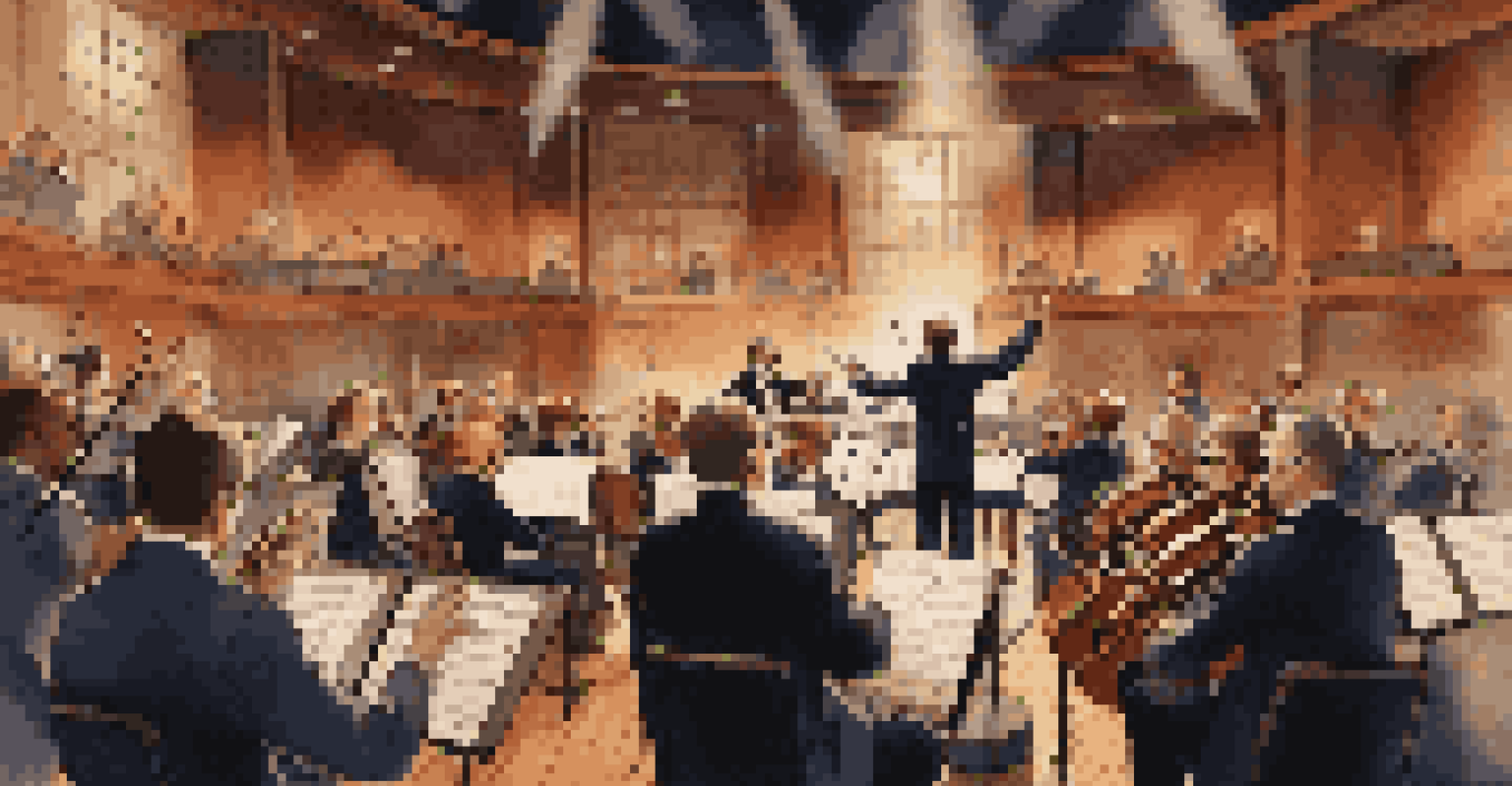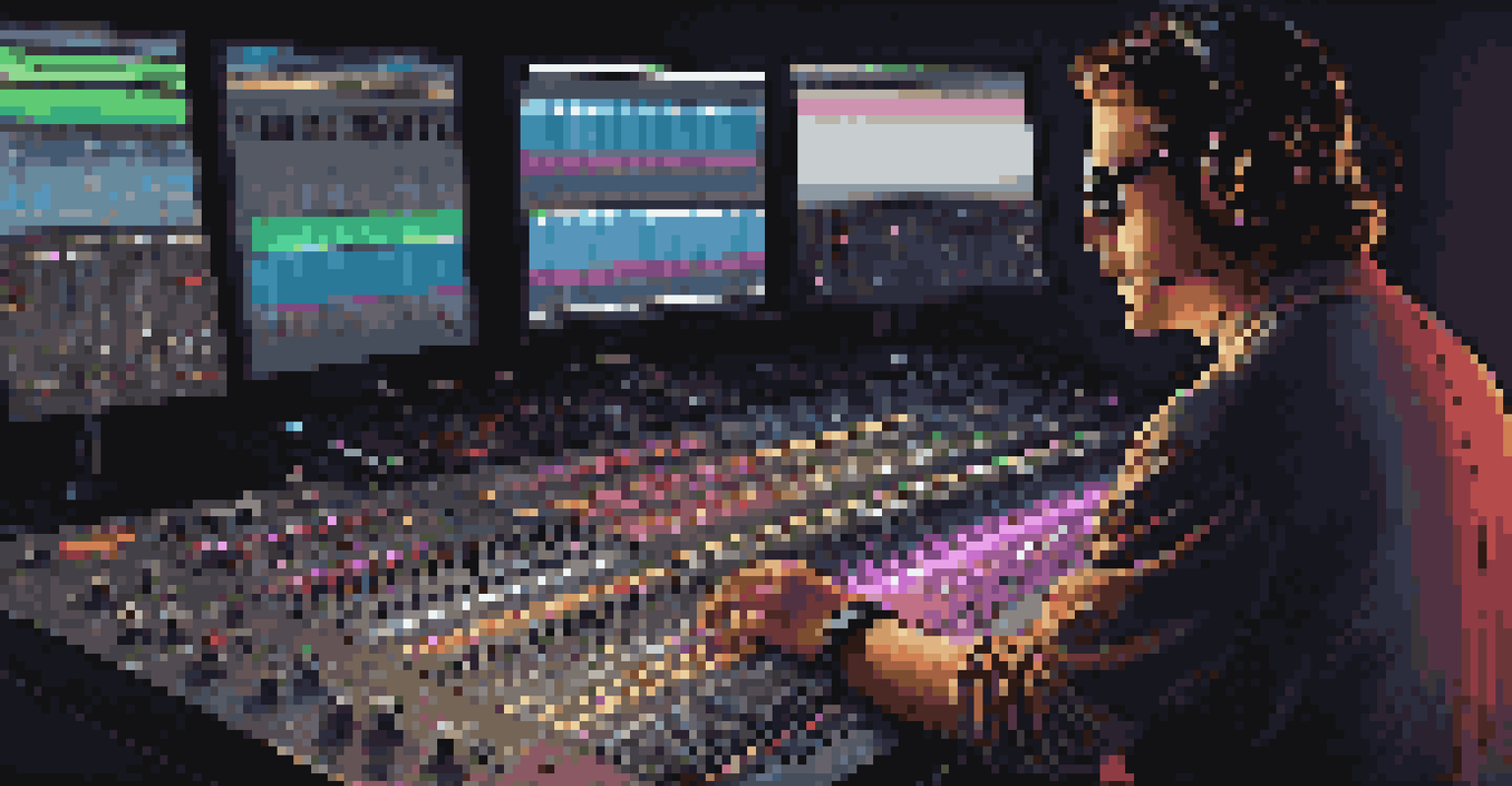The Process of Recording Orchestral Scores for Film

Understanding the Role of Orchestral Scores in Film
Orchestral scores serve as the emotional backbone of a film, guiding the audience's feelings and enhancing the storytelling. Think of a thrilling chase scene; the music swells and quickens, mirroring the action on screen. Without these scores, movies would feel flat, lacking the depth that music brings to character development and plot progression.
Music can change the world because it can change people.
Composers carefully craft these scores to match the film's tone, ensuring that every note resonates with the visuals. For example, a heartwarming moment might feature soft strings, while a dramatic twist could unleash powerful brass. This careful tailoring creates a more immersive experience for viewers, weaving music and narrative into a cohesive whole.
Understanding this foundational role is crucial for anyone involved in the filmmaking process, from directors to sound engineers. By appreciating the importance of orchestral scores, all team members can better collaborate to create a memorable cinematic experience.
The Collaboration Between Composers and Filmmakers
The journey of creating an orchestral score begins with collaboration between the composer and the filmmaker. This partnership is essential as it allows both parties to share their visions and understand the story's emotional landscape. Regular meetings and discussions help bridge the gap between the visual elements and the musical components.

During these discussions, filmmakers often provide insights into specific scenes, allowing composers to craft music that embodies the film's essence. For instance, if a scene portrays a character's internal struggle, the composer might choose dissonant chords to reflect that tension. This collaborative effort ensures that the music aligns seamlessly with the film's narrative.
Orchestral Scores Shape Emotions
Orchestral scores serve as the emotional backbone of films, enhancing storytelling and guiding audience feelings.
Ultimately, this teamwork fosters an environment where creativity can flourish. By valuing each other's input, composers and filmmakers can create a score that not only complements the visuals but also elevates the overall cinematic experience.
Composing the Score: The Creative Process
Once the collaboration is established, the composer embarks on the creative process of scoring the film. This involves sketching themes and motifs that represent characters or specific emotions. Much like an artist choosing colors, a composer selects musical elements that convey the desired atmosphere.
Film is a powerful medium, and music is its soul.
As the score develops, composers often use software to digitally create and arrange the music before any live instruments are introduced. This step allows them to experiment with different sounds and orchestrations. For instance, they might try layering strings with woodwinds to evoke a sense of nostalgia in a flashback scene.
The initial compositions are then refined through feedback from the filmmaker and other team members. This iterative process ensures that the final score not only meets the creative vision but also fits seamlessly within the film’s narrative structure.
Preparing for the Recording Session
With the score finalized, the next step is preparing for the recording session. This involves organizing the musicians, selecting the right recording studio, and planning the logistics of the session. Think of this phase as setting the stage for a grand performance; every detail matters.
The conductor plays a vital role in this stage, interpreting the score and guiding the musicians through the recording. Detailed rehearsal schedules are created to ensure that every section of the orchestra is well-prepared. For example, strings may need extra time to perfect their harmonies, while brass could focus on tuning and articulation.
Collaboration is Key in Scoring
The partnership between composers and filmmakers is essential for creating music that aligns with the film's narrative.
Additionally, sound engineers begin setting up microphones and equipment to capture the best possible sound quality. This preparation is crucial to achieving that rich, full orchestral sound that audiences have come to love in film scores.
The Recording Process: Bringing the Score to Life
The recording session is where the magic truly happens, transforming notes on a page into a living, breathing orchestral performance. As musicians gather in the studio, the atmosphere is charged with energy and anticipation. Musicians rely on their training and experience to interpret the score, bringing their unique artistry to the performance.
The conductor leads the session, ensuring that every nuance of the score is captured. Each take is recorded, allowing for multiple versions of a piece to be reviewed later. This process might involve repeated takes of particularly challenging sections, ensuring that the performance is polished and refined.
After the session, the recordings are reviewed, and the best takes are selected for mixing. This phase is crucial, as it fine-tunes the balance of instruments and enhances the overall sound, ensuring that the orchestral score truly complements the film.
Post-Production: Mixing and Mastering the Score
Once the recording is complete, the next phase is post-production, where the raw tracks are mixed and mastered. This step involves adjusting levels, panning instruments, and adding effects to create a polished final product. Think of it as the finishing touch on a painting, where every detail is refined to perfection.
Sound engineers work closely with the composer to maintain the integrity of the original score while enhancing its impact. They may add reverb to create a sense of space or adjust equalization to ensure clarity in the mix. This collaboration allows the score to resonate well within the film’s audio landscape.
Post-Production Refines the Score
The mixing and mastering processes in post-production ensure that the final orchestral score is polished and impactful.
The mastering process ensures that the final score is ready for distribution, whether it's for the film's release or its soundtrack album. This meticulous attention to detail guarantees that the orchestral score will leave a lasting impression on the audience.
The Impact of Orchestral Scores on Film Experience
The orchestral score doesn’t just accompany the film; it shapes the audience's entire viewing experience. A well-crafted score can evoke profound emotional responses, heightening suspense, joy, or sadness within specific scenes. For example, the iconic score from 'Star Wars' is instantly recognizable and transports viewers into a galaxy far, far away.
The emotional power of music in film is so significant that it often lingers in viewers' minds long after they've left the theater. Many people can recall specific scores associated with their favorite movies, showcasing the deep connection between music and memory. This emotional imprint is what makes orchestral scores an indispensable part of filmmaking.

Ultimately, the process of recording orchestral scores is a collaborative art form that enriches the storytelling experience. By understanding and appreciating this intricate process, audiences can gain a deeper appreciation for the role music plays in their favorite films.